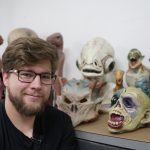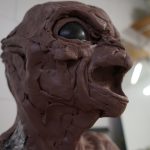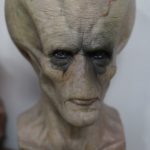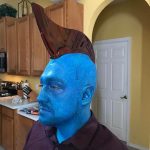
By day, he is a neuroscientist, a cellular biologist and biomaterials researcher. By night he brings monsters, aliens and zombies to life using the magic of special effects make-up.
A senior research technician at the College of Medicine’s Burnett School of Biomedical Sciences, Alex Bosak works in the lab of Dr. Brad Willenberg. Together, they study mosquitoes to help curb diseases the insects transmit like the Zika virus. They also create biomaterial scaffolds — manmade tissues that are used for regenerative medicine, wound healing and nerve regeneration.
But when Bosak is not in the lab fighting Zika, you can probably find him in a makeshift art studio in his garage using prosthetic sculpting, molding and casting techniques to create harrowing masks and sculptures.
“I basically recreate aliens, creatures and monsters from different films that I like,” said the UCF grad, whose masterpieces include Demogorgon from the series, Stranger Things, a number of aliens from Star Wars, Velociraptor from Jurassic Park and his most popular piece this Halloween, Scary Terry from Rick and Morty. “People just love that!” he said.
After watching his high school English teacher suffer with multiple sclerosis, Bosak developed an interest in the brain, , which led him to pursue to a degree at in molecular microbiology with an emphasis in neurosciences.
It was during his undergraduate studies that he first discovered his hidden talent. He was working at Universal Studios part-time as a cast member in the Rocky Horror Show live stage performances. He played the part of Rocky Horror and saw special effects makeup artists bring characters to life with prosthetics, masks and airbrushing.
“I thought it was pretty cool, and I decided I wanted to learn how to do that.”
Shadowing one of the make-up artists, he first learned to make the noses for the characters in How The Grinch Stole Christmas production and was soon offered a job doing that. But he wanted to learn and do more. So he pored over online videos, practiced on his friends, and with a lot of trial and error in between, he perfected his art.
Pretty soon, he was creating blood-curdling zombies for The Walking Dead attraction at Universal’s Halloween Horror Nights and doing special effects make-up for several independent films.
“There is a lot of crossover and understanding the science of art really helps me,” Bosak said. “To make these characters look real, they have to follow nature and so if a bone isn’t supposed to go there, you can kind of tell it’s a weird design. So having an understanding of anatomy and physiology and how the musculoskeletal system should work really helps with designing the sculpture.”
For his horror projects he uses similar materials to what he uses in the lab, such as silicone and alginate, for mold making and casting.
“Working with Dr. Willenberg on biomaterials has definitely pushed my understanding of art and made me a lot more confident working with any material that I have my hands on,” He said.
Though he has given up the job at Universal to work full-time doing research at the College of Medicine, Bosak has kept doing special effects make-up as a hobby. He does masks and makeup for friends and family for Halloween parties and special events like comic book conventions.
Ultimately, Bosak wants to combine his passions and bridge the gap between art and medicine by designing stand-ins that can be used in medical training and simulations instead of cadavers or actual body parts.
“I want to design something that is as realistic as possible for students and other doctors practice on in the absence of actual cadavers,” Bosak added. “I want it to be reactive, for example if you inject a certain amount of liquid or administer a drug, the mannequin would be able to give some feedback or response. There is definitely a market for it and I think it’s a good way to use my skills to contribute to the medical community.”
Bosak’s work was featured Monday on Fox 35 News. Watch the clip here.



